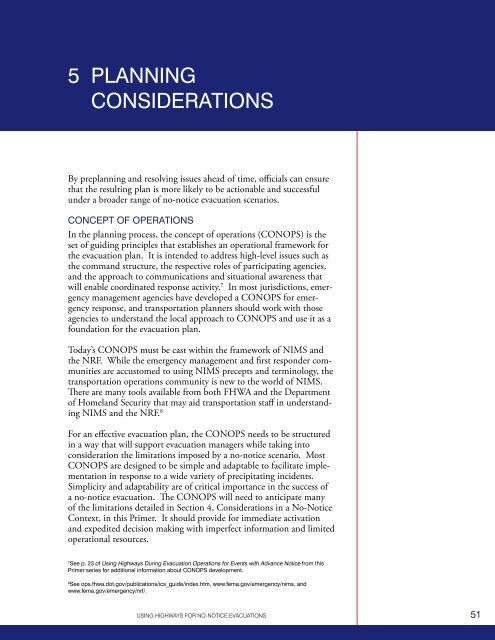using highways for no-notice evacuations - FHWA Operations - U.S. ...
using highways for no-notice evacuations - FHWA Operations - U.S. ...
using highways for no-notice evacuations - FHWA Operations - U.S. ...
Create successful ePaper yourself
Turn your PDF publications into a flip-book with our unique Google optimized e-Paper software.
5 PlanningPlanning considerations ConsiderationsBy preplanning and resolving issues ahead of time, officials can ensurethat the resulting plan is more likely to be actionable and successfulunder a broader range of <strong>no</strong>-<strong>no</strong>tice evacuation scenarios.Concept of <strong>Operations</strong>In the planning process, the concept of operations (CONOPS) is theset of guiding principles that establishes an operational framework <strong>for</strong>the evacuation plan. It is intended to address high-level issues such asthe command structure, the respective roles of participating agencies,and the approach to communications and situational awareness thatwill enable coordinated response activity. 7 In most jurisdictions, emergencymanagement agencies have developed a CONOPS <strong>for</strong> emergencyresponse, and transportation planners should work with thoseagencies to understand the local approach to CONOPS and use it as afoundation <strong>for</strong> the evacuation plan.Today’s CONOPS must be cast within the framework of NIMS andthe NRF. While the emergency management and first responder communitiesare accustomed to <strong>using</strong> NIMS precepts and termi<strong>no</strong>logy, thetransportation operations community is new to the world of NIMS.There are many tools available from both <strong>FHWA</strong> and the Departmentof Homeland Security that may aid transportation staff in understandingNIMS and the NRF. 8For an effective evacuation plan, the CONOPS needs to be structuredin a way that will support evacuation managers while taking intoconsideration the limitations imposed by a <strong>no</strong>-<strong>no</strong>tice scenario. MostCONOPS are designed to be simple and adaptable to facilitate implementationin response to a wide variety of precipitating incidents.Simplicity and adaptability are of critical importance in the success ofa <strong>no</strong>-<strong>no</strong>tice evacuation. The CONOPS will need to anticipate manyof the limitations detailed in Section 4, Considerations in a No-NoticeContext, in this Primer. It should provide <strong>for</strong> immediate activationand expedited decision making with imperfect in<strong>for</strong>mation and limitedoperational resources.7See p. 23 of Using Highways During Evacuation <strong>Operations</strong> <strong>for</strong> Events with Advance Notice from thisPrimer series <strong>for</strong> additional in<strong>for</strong>mation about CONOPS development.8See ops.fhwa.dot.gov/publications/ics_guide/index.htm, www.fema.gov/emergency/nims, andwww.fema.gov/emergency/nrf/.USING HIGHWAYS FOR NO-NOTICE EVACUATIONS51
















